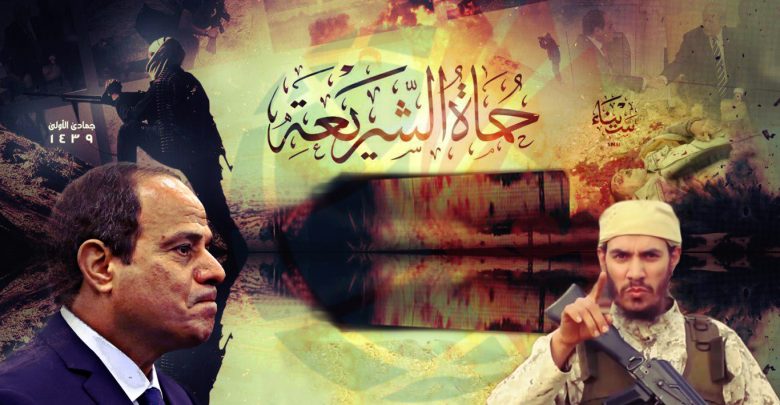
Protectors of Sharia: MSGS & Missing Scenes
Protectors of Sharia: MSGS & Missing Scenes.
Introduction
On February 11, 2018, the Islamic State’s (IS) local affiliate ‘Sinai Province’ released a 23-minute video, in which it showcased several scenes of its recent attacks against the Egyptian Army. The IS video came in coincidence with the anniversary of former President Hosni Mubarak’s stepping down, and the Egyptian military’s announcement of launching Operation Sinai 2018.
This paper is an attempt to provide answers for the following questions:
– What messages did the IS’s Feb. 11 video want to send?
– How did Sisi contribute to the aggravation of the Egyptian crisis?
– Was Sisi able to spare Egypt a fate similar to that of Syria or Iraq – as he had promised? Or Is he (Sisi) taking the country to the same fate (of Syria and Iraq)?
On the anniversary of Mubarak’s stepping down:
The IS ‘Sinai Province’ was keen on releasing the video, ‘Protectors of Sharia’, at this particular time (Feb. 11), which coincides with the anniversary of the removal of former President Mohamed Hosni Mubarak, which was considered a victory by revolutionaries and political movements over the repressive institutions of the Egyptian regime at the time. The video also addressed the concept of ‘Hakimiyyah’ [sometimes defined as the highest governmental and legal authority – i.e. God’s sovereignty, and supremacy of His Sharia which must be the only reference to governance]. In this context, the video attacked ‘Democracy’ and those who believed in democratic governance for “giving people the absolute right to ‘legislation’, which may lead to issuance of anti-Islamic laws. To prove the Islamic State thoughts, the video cited some Quranic verses (which they were explained in a way that could support the organization’s convictions).
The video adopted a method of persuasion that depended on highlighting conflicting comments made by some IS opponents, particularly on issues such as “elections”, the “constitution”, or “democracy”, including:
– Contradictory fatwas about “democracy” (before and after the January revolution), issued by Sheikh Yasser Borhami – a prominent Salafi preacher who supported Sisi in his military coup against Mohamed Morsi.
– Conflicting fatwas about “elections” and the “constitution” (before and after the revolution) by Sheikh Mohammed Abdul Maqsoud – a well-known Salafi preacher who supported the Muslim Brotherhood against Sisi’s July 4 military coup.
– Likewise, the video quoted Sheikh Mostafa al-Adawi while urging people to participate in the 2012 presidential election, against his previous convictions.
Based on this, the video mainly wanted to send the following messages:
– The application of Islamic Sharia (law) can never come through the practice of democracy.
Sisi and Blood of Revenge
Despite the fact that before his access to power, Abdel-Fattah Al-Sisi announced that he was against targeting civilians in Sinai, however his actions after the military coup on July 3, 2013, were completely different. Al-Sisi unleashed the military and security forces on his opponents in general, and on the people of Sinai in particular, which led to the emergence of armed insurgency in the peninsula; and even part of this insurgency swore allegiance to the Islamic State (IS). Through extrajudicial killings of civilians, enforced evictions, and highlighting intimate relations between Sisi and Israel, Abdul Fattah al-Sisi and his military and security services – whether intentionally or unintentionally – have created a state of revenge among the people of Sinai, particularly the youth. Anyway, this was partly in favor of the Islamic State, which benefited from highlighting the intimate relationship between Sisi and Netanyahu, and the killing of children and destruction of homes and mosques at the hands of the Egyptian army. For example, the video showed one of the ‘Sinai Province’ militants while threatening Sisi and the army of retaliation for the demolition of people’s homes in Sinai. Also, the video showcased IS militants while confronting the army’s act of forcibly evicting people in Rafah – through targeting the participating forces and military vehicles – showing the militant group as the only protector of people in Sinai, and in Egypt in general.
A failed army
The producers of the video were keen on showing how far the Egyptian army is a failed institution by making fun of the military in several ways, including:
– Showing scenes of army soldiers while walking in front of a mine detection armored vehicle, not behind it, which makes targeting the soldiers easier.
– Showing scenes of a mine-resistant ambush protected (MRAP) vehicle – a highly armored vehicle designed specifically for withstanding improvised explosive device (IED) attacks and ambushes – which was detecting IEDs while one of its doors was open, which eliminates its effectiveness and makes it an easy target for militants’ attacks. This highlights the fact that the soldiers driving these vehicles are technically unfit.
– Showing an explosive detection armored vehicle (at the minute 11 and 38 seconds of the video) while parking next to an explosive device. Meanwhile, an armored vehicle nearby was attacked before the explosive detection armored vehicle itself was targeted.
– Revealing information about the process of tracking the helicopter of defense and interior ministers for a long time before targeting it, highlighting the extent of failure of the army and security forces, which failed even in securing and protecting their superiors.
The model
The video shows the IS focus on Egypt, in particular, where the regime’s acts of repression and grievances have been increasing, while the opposition are unable to provide any alternatives.
Amid frustration of young people who once thought they got rid of the security forces’ suppression in the January 25th revolution, the IS ‘Sinai Province’ video presented an example for those frustrated young people who seek revenge from Egyptian military and security institutions, Omar al-Deeb. Al-Deeb was an Egyptian university student of media in Malaysia, where he lived with his family from 2009. Omar is son of a Muslim Brotherhood member, Egypt’s main opposition civil force. Omar left his family in Malaysia under the pretext of visiting his relatives and friends in Egypt, but instead, he travelled to Iraq and swore allegiance to the Islamic State and then moved to Egypt. The IS ‘Sinai Province’ was keen on showing Omar as an example to be imitated by frustrated young people in joining the militant organization. Also, the IS exploited the inaccurate coverage of Omar’s death by some opposition media outlets in stressing that it is the only organization that is trustworthy for the youth. Moreover, the video launched a severe attack on the Muslim Brotherhood movement – describing it as ‘renegade’ – as well as other political forces that are opposed to the regime. “Peacefulness is shameful; while fighting is the path of the righteous,” according to the IS ‘Sinai Province’ video, which added that “Just as the security forces and the army kill the Egyptian people, they are also being killed.”
It is noteworthy that the IS video highlighted some statements broadcast by some opposition TV channels to question their credibility, as the IS considers as hostile as the pro-regime channels towards them – despite the fact that these comments were taken out of their context. Furthermore, the IS approach of focusing on fabricated claims of enforced disappearance – that Omar’s father himself denied – only reinforces Al-Sisi’s narration that “there is no enforced disappearance in Egypt, and that these (disappeared) young people had joined the IS”. Dr. Ibrahim al-Deeb, father of Omar, in a TV interview on October 8, 2017 said was not sure that his son was subjected to enforced disappearance. “I do not know if my son Omar was forcibly disappeared or not, as I heard about his death from the media,” Dr. Al-Deeb said explicitly. Also, the human rights organizations concerned have not reported that Omar al-Deeb was exposed to enforced disappearance. All that had been mentioned was calls for conducting investigations into the possibility of exposing Al-Deeb and others to physical liquidation after being arrested alive.
Missing scenes in the video of ‘Protectors of Sharia’
Why has the IS ‘Sinai Province’ organization deliberately ignored any talk about the massacre of Al-Rawdah mosque attack, in which 314 worshipers were killed inside the mosque, and everyone was keen to renounce it except for the IS-affiliated organization? While the Sinai Province’s latest video was titled: “Protectors of Sharia”, and the organization presents itself as the protector of Sharia, how can we imagine that it refrains from commenting on the biggest incident of targeting a mosque and worshipers during prayers?
Since the Al-Rawda Mosque attack, the Sinai Province has released more than one video, including that of targeting the helicopter of defense and interior ministers at Al-Arish airport, and the latest video of “Protectors of Sharia”, which included recent scenes of events in Sinai. So, why does the IS organization keep silent about the Al-Rawda Mosque incident? Or does the IS intentionally ignore talk about this massacre because of involvement of some of its members in the crime?
Missing Questions
We can easily observe the extent of change experienced by the IS ‘Sinai Province’ in Sinai. During the era of former Sinai Province spokesman, ‘Abu Osama al-Masri’, and its former leader, Abu Doaa Al-Ansari, the IS discourse used to express sympathy with victims of the Egyptian security forces’ massacres such as Raba’a al-Adawiya, and others. However, in the latest video, scenes of the Raba’a massacre were shown in the context of criticizing Muslim Brotherhood’s peaceful approach and engagement in the democratic process. “This is the punishment for those who believed in ‘democracy’,” an IS member commented in the video clip. The question is: Is the IS ‘Sinai Province’ witnessing a new stage of brutality after the murder of its early leaders? Even though the video was titled “Protectors of Shariah”, the Sinai Province avoided commenting on the biggest incident that targeted the Sinai worshipers in the village of Al-Rawda, which is considered by many observers to be evidence of their involvement in the massacre.
On the other hand, the IS organization talked about an imminent victory in Sinai in attempt to confirm the poor consequences of democracy, but the militant organization deliberately ignored any mention of its experience in the cities of Iraq’s Mosul, and Syria’s Raqqa, where its fighters were unable to withstand the air strikes that left most of the two cities in ruins, and led to killing thousands of civilians. Does the IS ‘Sinai Province’ want to expose Sinai to a fate similar to that of Mosul and Raqqa?
As for the Egyptian military institution, do the scenes shown in the video release not reflect the failure of the security solutions based on repression, killing and displacement? Can an institution that failed to protect the ministers of Defense and Interior be victorious in confronting the largest armed rebellion witnessed by Egypt in recent years?
Also, how will the military respond to the challenge announced at the final seconds of the video, that it will issue a new comprehensive video recording on the military Operation Sinai 2018? Or is the military institution no longer interested in preserving its mental image amid Al-Sisi’s dominance which turned it into an internal tool of suppression?
Conclusion
It is not possible to ignore the implications of the policy of Abdel Fattah al-Sisi’s military regime in Sinai, which contributed to the aggravation of the situation there and significantly increased grievances, leading to accumulation of revenge sentiment in the Egyptian community. Amid the escalating repression, violations, killing, displacement, arbitrary arrest, enforced disappearance, and absence of justice, Egypt is going towards further exacerbation of crises that will create a state of internal anger that could outburst at any time. This means that Egypt is going on the footsteps of Syria and Iraq because of the practices of the regime and its military commander, General turned President Abdul Fattah al-Sisi.




